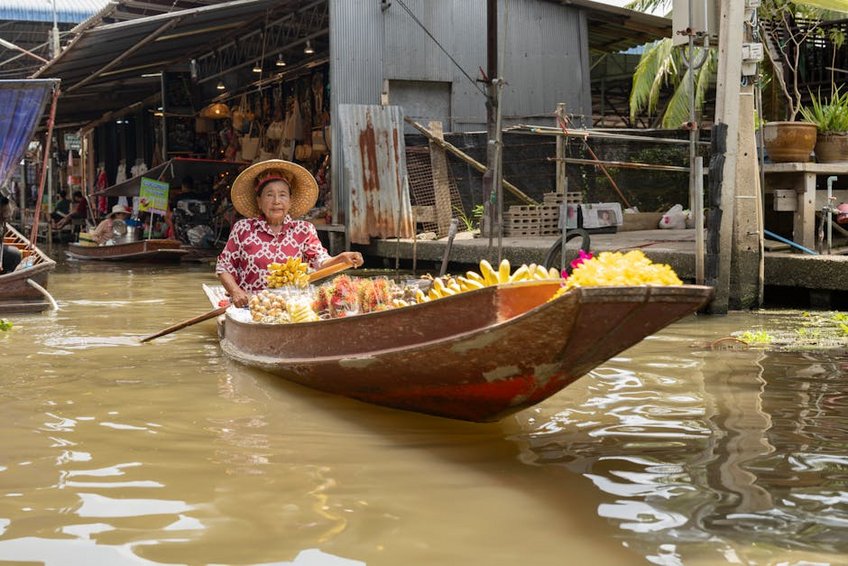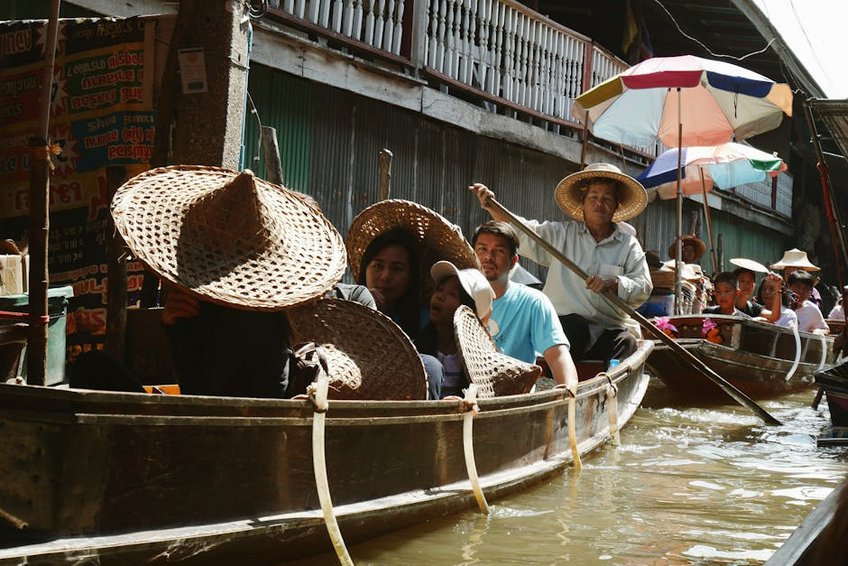Bangkok Floating Market – An Unforgettable Cultural Experience
Exploring a Bangkok floating market is one of the most iconic and authentic Thai experiences you can have during your visit to this vibrant city. These historic waterways, once the primary commercial arteries of ancient Siam, offer a fascinating glimpse into Thailand’s rich cultural heritage and traditional way of life. As you glide through the narrow canals on a wooden longtail boat, the vibrant sights, sounds, and aromas create an unforgettable sensory experience that transports you back in time. From sampling delicious local street food served directly from boats to bargaining for handmade crafts and souvenirs, a visit to a Bangkok floating market provides a unique perspective on Thai culture that you simply can’t find in the modern shopping malls of the city center. Whether you’re a first-time visitor or a seasoned Thailand traveler, these markets offer an authentic cultural immersion that will leave you with lasting memories and incredible photographs.
Bangkok Floating Market – Essential Information
Understanding the history and significance of Bangkok’s floating markets will greatly enhance your visit. These markets date back to the 19th century when the extensive network of canals (known as khlongs) served as the main transportation routes for both people and goods. Before modern roads were built, vendors would paddle their boats through these waterways, selling fresh produce, cooked food, and household items to residents living along the banks. Today, while some markets have become more tourist-oriented, they still maintain their traditional charm and offer genuine cultural experiences. The most authentic markets are typically located outside the city center, requiring an early morning start but rewarding visitors with fewer crowds and more authentic interactions with local vendors.
Types of Floating Markets – What You Need to Know
- Authentic local markets like Taling Chan and Khlong Lat Mayom operate primarily for Thai visitors and offer genuine cultural experiences with fewer tourists
- Tourist-oriented markets including Damnoen Saduak and Amphawa feature more souvenir shops and photo opportunities but maintain traditional elements
- Weekend-only markets that combine floating market experiences with land-based sections offering additional shopping and dining options
- Budget option: Public transportation and market entry costs approximately $15-20 per person including simple meals
- Mid-range option: Organized group tour with transportation, boat ride, and guided experience costs $40-60 per person
- Luxury option: Private tour with premium transportation, photographer, and exclusive experiences costs $100-150 per person
- Tourism Authority of Thailand Official Website
- Lonely Planet Bangkok Travel Guide
Market Hours and Timing – Key Details
Most Bangkok floating markets operate during specific hours, typically from early morning until early afternoon. The authentic markets are best visited between 7:00 AM and 9:00 AM when the weather is cooler, the light is perfect for photography, and the markets are at their most vibrant. Tourist markets like Damnoen Saduak remain open until around 11:00 AM but can become extremely crowded by mid-morning. Weekend markets often have extended hours until 2:00 or 3:00 PM. It’s crucial to check the specific operating days for each market, as some only operate on weekends while others are open daily but with reduced vendor participation on weekdays.

Bangkok Floating Market – Planning Your Trip
Proper planning is essential for making the most of your Bangkok floating market experience. The location of these markets outside the city center means you’ll need to allocate at least half a day for your visit, including transportation time. Most markets are located in Ratchaburi, Samut Songkhram, and Nonthaburi provinces, approximately 1-2 hours from central Bangkok depending on traffic conditions. It’s highly recommended to hire a private driver or join an organized tour for convenience, as public transportation to these areas can be challenging for first-time visitors. Booking in advance during peak season (November-February) is advisable, as these markets become increasingly popular with both domestic and international tourists seeking authentic Thai experiences.
Best Time to Visit Bangkok Floating Market
The ideal time to visit Bangkok floating markets is during the cool season from November to February when temperatures are more comfortable (around 25-30°C or 77-86°F) and humidity levels are lower. The early morning hours between 7:00 AM and 9:00 AM offer the best experience regardless of season, as you’ll avoid both the heat and the largest crowds. Avoid visiting during Thai public holidays and weekends if possible, as local visitors significantly increase crowd levels. The rainy season (May-October) can still be enjoyable if you don’t mind occasional showers, and the markets often have fewer visitors during this period, providing a more intimate experience.
Budget Planning and Costs
Essential Preparation Checklist
Preparing properly for your Bangkok floating market visit will ensure a more comfortable and enjoyable experience. Wear lightweight, breathable clothing that dries quickly as splashing water is common during boat rides. Comfortable shoes with good grip are essential for getting in and out of boats safely. Bring cash in small denominations (Thai baht) as most vendors don’t accept credit cards and may have difficulty making change for large bills. Essential items to pack include sunscreen, a hat, insect repellent, a reusable water bottle, and a waterproof bag for your electronics and purchases. Don’t forget your camera with extra memory cards, as you’ll encounter countless photo opportunities throughout your market experience.
Bangkok Floating Market – Top Attractions and Activities
The main attraction at any Bangkok floating market is undoubtedly the boat ride through the bustling canals, but these destinations offer much more than just floating vendors. Many markets feature extensive land-based sections with additional shopping opportunities, cultural performances, and cooking demonstrations. At Damnoen Saduak, you can watch traditional Thai dance performances and see artisans making coconut sugar. Amphawa Market is famous for its evening firefly watching tours after the market closes. Taling Chan offers excellent seafood restaurants where you can enjoy freshly cooked meals while watching boats pass by. Each market has its unique character and specialty products, from hand-woven textiles and wooden carvings to exotic fruits and traditional Thai desserts that you won’t find elsewhere.
Must-See Highlights
No visit to a Bangkok floating market is complete without experiencing these essential activities. The traditional longtail boat ride through the narrow canals is the centerpiece experience, allowing you to observe vendors preparing food and selling goods directly from their boats. Sampling boat noodles (kuay teow ruea) is a must-try culinary experience – these flavorful noodle soups are served in small bowls from specialized noodle boats. Watching vendors demonstrate coconut candy making provides fascinating insight into traditional Thai food production methods. Don’t miss the opportunity to taste seasonal tropical fruits like mangosteen, rambutan, and durian, often available at prices significantly lower than in Bangkok proper. The vibrant photography opportunities around every corner make these markets a photographer’s paradise.
Hidden Gems and Local Favorites
Beyond the main tourist attractions, Bangkok floating markets hide numerous lesser-known experiences that discerning travelers will appreciate. At Khlong Lat Mayom, seek out the elderly woman who makes traditional Thai kanom (desserts) using recipes passed down through generations. At Taling Chan, the freshwater fish massage experience offers a unique way to relax tired feet after exploring the market. Many markets have hidden temples or shrines nearby that few tourists discover – these peaceful spaces provide a quiet retreat from the market bustle. For authentic interactions, visit the less crowded sections where locals shop for their daily groceries – you’ll find better prices and more genuine experiences away from the main tourist thoroughfares.
Bangkok Floating Market – Practical Travel Information
Navigating your visit to a Bangkok floating market requires understanding the practical aspects of transportation, timing, and logistics. The distance from central Bangkok means you’ll need to plan your transportation carefully, with options ranging from public buses and trains to private taxis and organized tours. Most markets don’t require advance tickets for entry, but boat rides and specific activities may have separate pricing structures. English is spoken at the major tourist markets but less common at authentic local markets, so having a translation app or phrasebook can be helpful. The markets are generally safe, but standard tourist precautions regarding valuables and personal belongings should be observed, especially in crowded areas.
| Transportation Method | Travel Time from Bangkok | Approximate Cost (USD) |
|---|---|---|
| Private Taxi | 1-1.5 hours | $30-50 round trip |
| Organized Tour | Includes pickup | $40-60 per person |
| Public Bus + Songthaew | 2-2.5 hours | $5-8 per person |
| Train + Local Transport | 2-3 hours | $6-10 per person |


